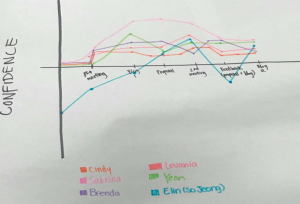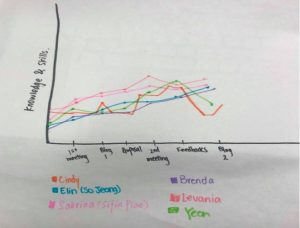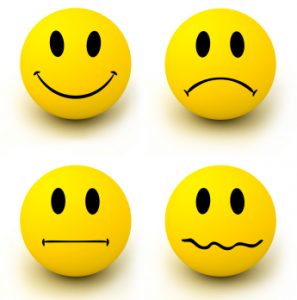‘Emotional!’ is the right word to describe what our group members have been experiencing throughout the week. We are encouraged to share our feelings and thoughts for the past months. It may be uncomfortable for us at the beginning, but hey, we all need to go beyond our comfort zone at one point. As we have open up to each of our members and our class, we decided to share this emotional journey with you. We have also included our objectives, accomplishments, why it matters and how we link it to our course materials.
On top of that, we have also conducted in depth research for programs and resources on the current food programs and policy around BC. We found some really interesting results that we can’t wait to share with you. So stay tuned for more exciting news from our team and don’t forget to come to our presentation on MARCH 26th in the NEST at 2:00 P.M!
From our last blog, we articulated some upcoming objectives for ourselves. Below is what our objectives were and a summary of what we were able to accomplish.
| Weeks | Objectives |
| Week 9
(Mar 5-11th) |
· Post Blog 3
· Gather all the resources (programs/research) and decide what to put on infographic |
| Week 10
(Mar 12-18th) |
· Start on infographic
· Have a group meeting to prepare for infographic, presentation and blog |
| Week 11
(Mar 19-25th) |
· Finish the infographic and prepare for presentation
· Receive feedback from program coordinators · Start on final report |
| Week 12
(Mar 26th – Apr 1st) Day of the Presentation! |
· Work on Blog 4 and post them
· Finalize final report |
| Week 13
(Apr 2nd – Apr 9th) |
· Edit and submit the final report |
Achievements achieved so far:
- The Resources team summarized policies and resources into an organized table consisting of different subheadings (Title, Name, Year, Type of Policy/Resource, Publisher, and Summary)
- The Program team delved further into different types of meal programs for Canadian schools and made the list in excel sheet. One thing we found interesting was that in addition to some schools having their own program, there was also catering services offered online from local organizations for parents and schools considerations.
- Had a meeting with our group during the Flexible Learning Session on Monday to discuss about our findings and discuss further steps
- Sent an email to Tara and Vicky asking about their availability to get feedback on our findings and infographic
Moment of Significant Change Workshop
During tutorial, we participated in an evaluation workshop called the Moment of Significant Change. This workshop allowed us to to be honest with each other by expressing what types of feelings, emotions and skills were developed during this project. Therefore, we were able to identify which moments we felt the most confident in and which moments were we least confident in. This allowed us to connect our emotions to skills and knowledge that we developed or felt like we were lacking in. We had an open conversation of our contributions, our worries and our strengths. We believe that this workshop helped us get closer to one another and strengthened our communication with each other. As we have discussed previously in our blogs, communication is extremely important for success in group work. We plan to have more open conversations and constructive feedback within our group so that there are no misunderstandings and the process can continue to move smoothly.
Below, you can see our truthful opinions and feelings of what we have felt so far. We will be updating these charts as the project progresses! The first graph is about our level of Confidence according to different checkpoints of our projects. The second graph is about our Knowledge and Skills acquired and/or contributed according to the specific checkpoints.

Graph 1: Confidence Curve. “ Moments of significant change” is on the y-axis, positive emotions are above the x-axis, while negative emotions are under the x-axis.

Graph 2: Knowledge & Skills Curve. “Moments of significant change” is on the y-axis, knowledge and skills are on the x-axis.
Cindy – Going into this project, I felt unsure of what to expect from the VFPC because I had never heard about them. However, despite my worries, I was still really interested in learning more about the school meal programs across Vancouver and British Columbia because I have had first hand experience with the lunch programs in schools. After the first meeting, I felt more confident because Tara and Vicky were extremely nice and understanding. There were definitely some ups and downs throughout this project, especially after receiving feedback. However, I think these ups and downs along with the feedback were needed to strengthen our team work. The different perspective gives us an opportunity to work harder towards achieving better results and meeting expectations and goals. I’m also very grateful for the chance to learn more about blogging and through that, learning more about my group members which is reflected in my Knowledge and Skills.

(http://erikadolnackova.com/how-to-use-your-emotions-to-manifest-your-desires-intentionally/)
Sabrina– I choose this project “Vancouver Food Policy Council” because I really interested in the topic of establishing a universal school lunch system across Canada. I used to volunteer at Nutrikids Program and help to organize nutrition knowledge workshops for Grade One kids at an elementary school which not provide school lunch program, therefore I felt very confident at the beginning of the term after our first meeting with community partners. Our group members work very efficiently and smoothly for our project proposal and we also asked our community partners’ feedback, however we didn’t get a satisfied mark and my confidence is decreasing. Based on the feedbacks, we can improve more on the details of our project and we noticed that there are some weakness in our proposal, for example, we didn’t follow the APA style and there are also some grammar mistakes. Through doing the blogs and proposal, I learn more knowledge and skills on how to do a perfect group work. For example, how to organize our flexible time efficiently and how to get valuable feedbacks from our community partners.

(http://erikadolnackova.com/how-to-use-your-emotions-to-manifest-your-desires-intentionally/)
Levania- When starting on the project, I didn’t know what was expected from us or who my group is going to be. I didn’t feel anywhere near confident in going into the project. However, after the first meeting with my group, I felt more comfortable and confident in working with my group members. After meeting our community partner, I became even more confident as they clearly elaborate what they were expecting us to do and what we can do to achieve it. As we dive more into our topic and begin our research, my confidence as well as my knowledge increases. I understood more about the issue of school food policy in Canada and what our community partners were doing to create a change. One of the biggest downfalls that I faced with my confidence and knowledge was after after the second meeting as we had a lot of assignments to do while not being sure of what is expected of us. However, now that we have been doing our blogs, submitting our assignments and meeting with our community leaders, things are more clear and understandable.

(https://upliftconnect.com/biology-and-culture-human-emotion/)
Brenda – Working with Vancouver Food Policy Council on school lunch programming across B.C. was my first preference for the community projects. However in the beginning, I wasn’t sure what the project is about and what our community partners expect from us. After our first meeting with our community partners, I felt more confident as Tara and Vicky clearly explained their expectation for us and guided us to start our research. My knowledge definitely increases as I did more research and read through more policies and sources while preparing for the excel sheet. However, my confidence started to decrease again as I started to get lost in the amount of resources found and given to us. During the process of this project, meeting up with group members and community leaders boosts up my confidence as we are able to share our findings and ask for clarifications and feedbacks. Tara and Vicky are also always willing to provide guidance and resources to us, and support us whenever we were lack in confidence. As we slowly became familiar with the topic of school lunch programs in B.C., things became more understandable and my knowledge level has significantly increased compared to the start.
Yeon– I chose the Vancouver Food Policy Council project as my first choice as I found it interesting that Canada did not have a national meal program for students like many other countries. I come from Korea where I remember having a lunch program available from elementary. Thus it made me naturally wonder why Canada did not have any programs yet, and was glad I got into this program to work on as my Community Based Learning. However, it was not easy to start on this project, as VFPC is just one council and we had to start from the very beginning. Tara and Vicky, who were our program coordinators were very supportive and understanding by providing resources and information we needed. It was not easy as we were having hard time finding vast information, but the feedbacks we have received have helped us greatly and hopefully the findings that we did will bring a cornerstone to make a universal food program.

(http://www.opensystemsinc.com/2018/01/30/here-are-the-top-skills-companies-are-looking-for-in-2018/)
Elin – Just like the rest of the members of my group, I also was not feeling too certain about what exactly this project is aiming for and how we, as a group, were supposed to approach the goal of this project. This term is the first time for VFPC to work with UBC LFS students, so we do not have any past VFPC projects to refer to. However, as we had our group meetings with our community partners and researched more thoroughly on our group project, I started to gain more understanding and knowledge on what it is that we are aiming to do, what we are trying to achieve. With the feedbacks we have gotten from our LFS colleagues during tutorial, our community partners, and our TA, I did lose the confidence in myself, thinking “will I really be able to give our community partners what they want for this project?” But I also was able to bring myself to be more focused on narrowing down what things to be researched more clearly on.
Relating this together as a group, we believe we all had some level of anxiety and uncertainty coming into this project. However, according to Schulman (2005), learning only occurs if you experience these emotions. The TED talk by Tim Harford also mentioned that creativity occurs when you are placed to work with strangers instead of with friends.
You can watch the video below for an interesting talk about working in “messy” situations.
This is because working with strangers requires more attention and for you to be more alert and focused. Although these situations may be uncomfortable at first, stepping out of our comfort zone will only benefit us towards success and strengthen our group-work skills for the future. We should learn to embrace these uncertainties and messy situations because the notion of failure is necessary to feel a higher sense of responsibility to succeed.
Another important concept with group-work is the Asset-Based Community Development framework, as explained by Mathie and Cunningham (2003). The active listening and communication between a group is essential provide a meaningful and respectful relationship. We do believe we have a strong relationship because we have been respectful of each other and utilized the skills that we have to work collectively as a team.
We will now be incorporating the What? So what? Now what? Framework by Rolfe et al. (2001) to develop an effective strategy to complete the project with continued ease.
WHAT are some of our strengths and weaknesses?
| Strengths: | Needs Improvement on: |
| Punctuality – Being on top of our tasks is something we have been really good at. We have been punctual in submitting our works and also having some spare time to edit and recheck. | Preparedness- Come more prepared to the group meetings by doing research on more variety of ideas to be brought into the project. |
| Communications– Through social media, our group members have been actively communicating even outside of school. With our program coordinators, we have been getting in contact with them through email and we have been receiving replies quite fast. | Delegation of tasks- As we find it more efficient, our group liked to meet up after class and do the project work together. Our goal is to divide up the work so we can save the time we have to meet up, as it is not the easiest for all members to meet up all the time. |
| Teamwork – Individual ideas were always shared each group meeting and helped on each other’s weaknesses by giving feedbacks. | Clarity– When working on our assignments, many times our group had a hard time understanding what the exact outcome is expected from us. Hence, we need to communicate better with our TA in clarifying the details of what is expected from us. |
SO WHAT? Why is this important for us?
The table above with areas of strength and areas needing improvements are used as a guidance to help our group to successfully complete the project. With this table as a reference, we will be able to stay on task and always be reminded on what things we have to mainly focus on to overcome our weaknesses. This table shows us that we are effective in communicating within our groups but we may need to use our resources better. For example, we can greatly benefit from compiling questions together to ask our TA Steph so that we can be more clear on what is expected from us. This will ultimately allow us to achieve some of our upcoming objectives in a detail and constructive manner.
NOW WHAT?
Our strategies for successful project completion include:
- To organize our time sufficiently and set deadlines for the infographic and final paper ahead of time.
- To communicate efficiently and keep all group members and community partners updated on the progress of the project
- To constantly present our findings and receives feedbacks from our community partners by setting a meeting time before the presentation date
- To work on rough drafts together and ask for feedbacks from TA and community partners, then complete the final version
- To reflect back on our uncertainties and ask for clarification
- To make flexible learning time more efficient and coming up with more valuable ideas by including better delegation of tasks
Below is a table summarizing our upcoming deadlines. We will be finishing these projects before the actual deadline so that we can edit and finalize the final copy together as a group.
| To Do | Our Deadline | Actual Deadline |
| Meeting with Tara and Vicky | ??? TBD | ———- |
| Rough infographic | March 19th | March 22nd |
| Infographic | March 25th | March 25th |
| Presentation/Elevator Pitch | March 20th | March 26th |
| Blog 4 | March 26th | March 30th |
| Work Individually on Report | March 26-April 3rd | ——— |
| Final Report (Edit) | April 3rd | April 8th |
Thank you for reading!
References:
Mathie, A., & Cunningham, G. (2003). From clients to citizens: Asset-based Community Development as a strategy for community-driven development. Development in Practice, 13(5), 474–486.
Shulman, L. S. (2005). Pedagogies of uncertainty. Liberal Education, 91(2), 18–25. Retrieved from http://files.eric.ed.gov/fulltext/EJ697350.pdf